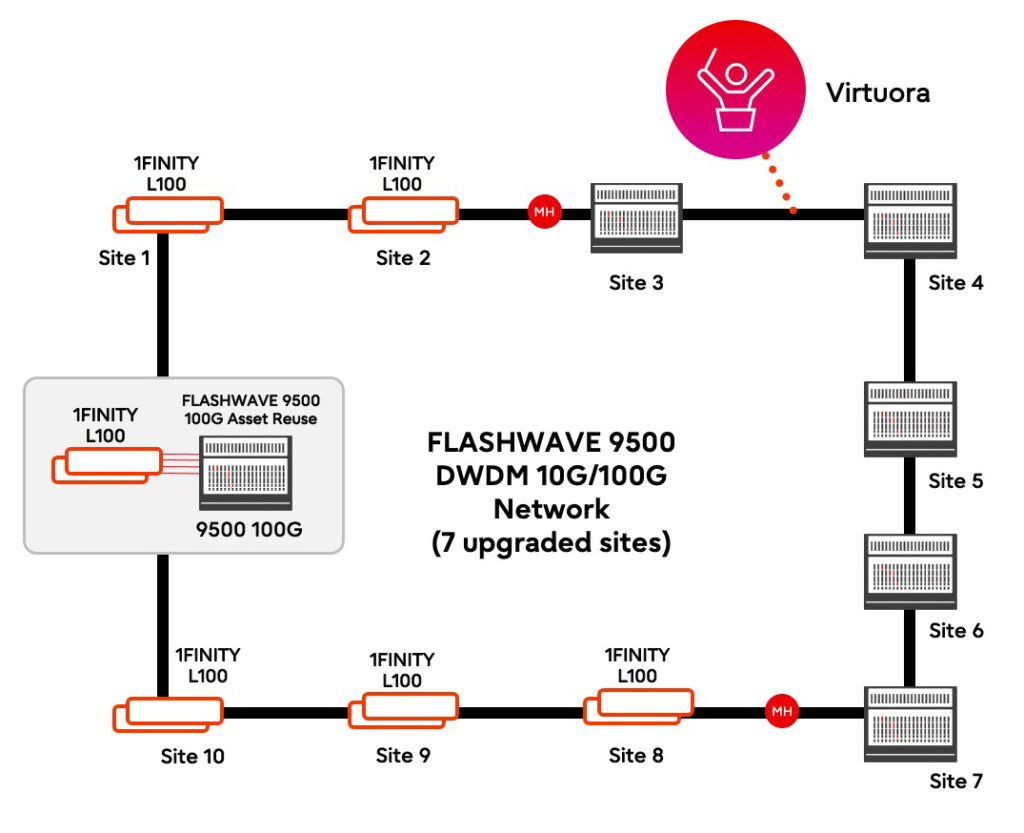
In the last few years, I have noticed changes among our tier 2 and 3 FLASHWAVE 9500 conventional ROADM customers regarding how they are thinking about network evolution and modernization. The FLASHWAVE 9500 has formed the foundation of their network for over 15 years now, and while it’s a great choice for transporting traffic up to 100G, the platform is not equipped with the technology required to enable transmission above 100G, such as flexible-grid capability as well as DCM-Less amplifiers.
Evaluating network modernization options in a changing environment
Many of these customers have considered moving away from FLASHWAVE 9500 altogether, typically by deploying an overlay network which meets new high-speed services requirements while gradually phasing out their FLASHWAVE 9500 network. There was little to no interest in reusing or augmenting their existing network.
But times have changed, especially in terms of available capital and growing pressure to make business and technology more profitable and sustainable. Following on the heels of multiple interest rate hikes and several years of economic uncertainty, funding is harder to secure, and in many cases, investors are leery of the high cost and technical challenges of building communications networks. Today, the overlay network option may not seem so attractive. To begin with, overlay networks require an extended deployment timeline and investors want a quicker return on investment.
Fiber availability is also a challenge for many service providers and a complete overlay network requires a new fiber pair on every span. Additionally, the large number of deployed FLASHWAVE 9500 100G cards in the current network are an asset worth reusing in the new modernized network. Overall, a reduce, reuse and recycle mindset is becoming more pervasive.
A pay-as-you-go network modernization solution
The most effective solution to modernize FLASHWAVE 9500 infrastructure is not to overlay it, but to augment it starting with as little as a single 1FINITY node to meet immediate capacity growth and gradually transition from there.
Overlay networks consume scarce fiber pairs
As previously mentioned, if you implement a complete overlay, you will require an additional fiber pair on every span—a big obstacle for many tier 2 and 3 providers who may not necessarily have access to additional fiber pairs on every span. But, when evolving a FLASHWAVE 9500 based network with 1FINITY, you do not necessarily require additional fiber pairs.
An overlay adds complications, breaks continuity
Overlays also have other disadvantages. When deploying an overlay, you are required to build the entire network on day one with at least one node at every site, and you will operate two distinct networks side-by-side during the migration. Alternatively, with a 1FINITY evolution, you maintain end-to-end continuity across both the existing and the new network as they are managed as a single infrastructure. The migration can organically be performed in any order, at your own pace, add capacity only when needed, while managing a single network.
An overlay network is When it comes to network controllers, evolving with 1FINITY can be managed using the existing NETSMART 1500 controller that manages the FLASHWAVE network until the point where it becomes necessary to move to 1FINITY L-Series ROADMs. If you’re adding Transport platforms like the T300 and T310, these can be managed using NETSMART 1500.
Overlay networks typically require a number of “back-to-back” transponders in order to transition traffic from the existing network to the overlay network. This additional cost is not required when modernizing networks from a FLASHWAVE 9500 one to a 1FINITY based network. Fujitsu’s network evolution solution helps reduce cost, simplify the transition, and reduce power consumption by eliminating unneeded transitionary equipment.
Last, but not least, you have a single source of support with Fujitsu for both your existing and your new modernized ROADM infrastructure.
Network modernization for flexible grid
Some service providers have postponed introducing flexible grid for as long as they possibly could, in order to defer the cost. However, flexible-grid is necessary in order to deploy 400G+ line rates. Most of the existing FLASHWAVE 9500 networks were originally deployed for compensated 10G transmission and 100G Coherent transmission was gradually introduced without removing the dispersion compensation modules or adding flexible grid capabilities. With the growth of 400G wavelengths, the time has come to move beyond 100G and many service providers cannot wait any longer to modernize their infrastructure. Evolution from FLASHWAVE 9500 to 1FINITY enables flexible grid, removes the dispersion compensation modules, and support 400G+ without the effort and cost of a complete overlay.
Don’t throw out those 100G cards
The ability to reuse previously purchased FLASHWAVE 9500 100G cards in the modernized, evolved network is an important cost saver. These cards often account for millions of dollars in capital expenditure, and they can be reused in the modernized evolved network—without requiring any unneeded complexity such as planning and managing alien wavelengths.
A hypothetical 1FINITY network modernization
The diagram below shows a hypothetical ring here of 14 FLASHWAVE 9500 nodes. It’s operating 10G and 100G cards, and it’s managed by NETSMART 1500. Customers have used infrastructure like this for more than a decade. It’s served them well, but now is the time to augment it, for high-speed services.

How to evolve the network
The first step is to address immediate capacity needs by deploying T-series transponders, specifically the 1FINITY T300, T310 and T700 over the existing infrastructure. This is the first step of introducing 1FINITY to this network. 1FINITY units are much smaller and, in most cases, there’s a price per bit improvement because the T300 happens to be cheaper than a FLASHWAVE 9500 100G unit. This is a seamless introduction, because the T300 and T700 are visible in the NETSMART 1500 controller.
The second step is to integrate the new ROADM technology on specific spans, initially by adding a 1FINITY L100 ROADM, connected to the FLASHWAVE 9500 system using a multihaul amplifier on the FLASHWAVE 9500. This is the point where it becomes necessary to introduce Fujitsu’s Virtuora network controller to manage the entire DWDM network as a single entity providing the ability to preserve 100G wavelength continuity between both the FLASHWAVE 9500 and 1FINITY sub-networks. The FLASHWAVE 9500 subnetwork is discovered by Virtuora’s WDM application, ensuring a graceful WDM services management transition from NETSMART 1500 to Virtuora.
Fujitsu build-operationalize-transfer network modernization solutions
While this process undeniably offers cost advantages over an overlay network, it does eventually require a transition to Virtuora Network Controller, and many service providers lack the expertise to operationalize a new controller while still managing their existing network. In this scenario, we can help with a Build-Operationalize-Transfer solution. A Fujitsu Network Services team can install, integrate, commission Virtuora, and transfer control when the service provider’s operations staff is ready to assume ownership of the new solution.
We’re here to help you move your network forward
Wherever you are in the process of network transformation, we’re here to help. Reach out to talk with us about your network evolution goals. And take a look at our brief on how to evolve your FLASHWAVE 9500 network to 1FINITY.